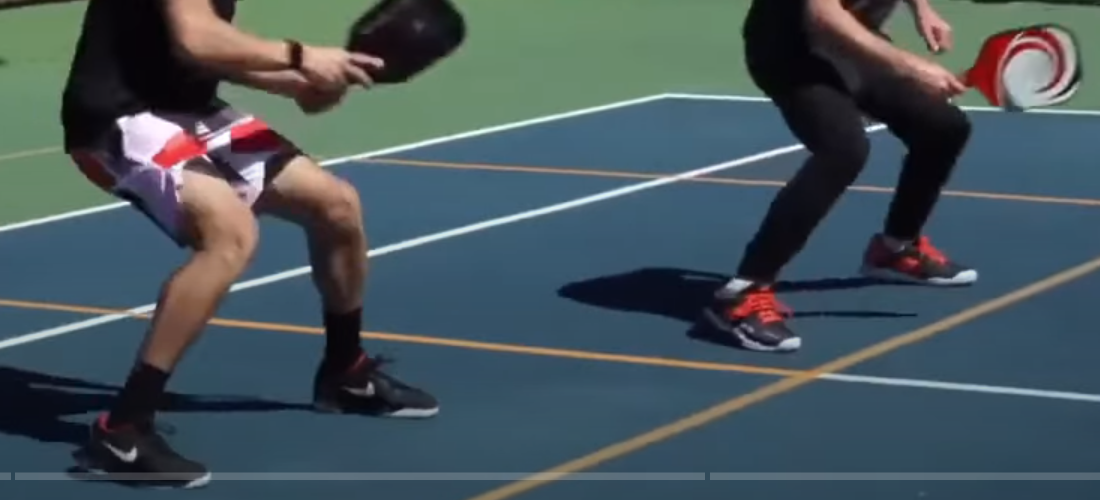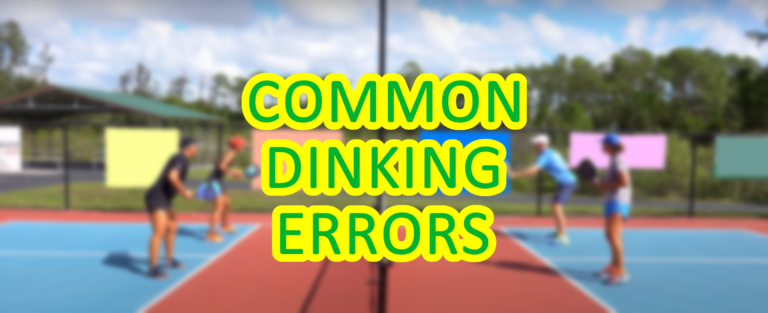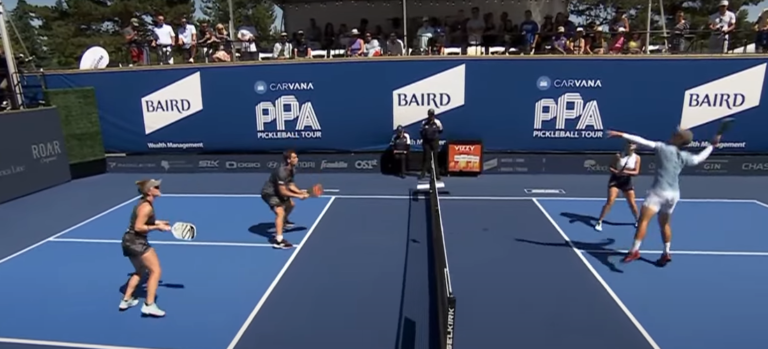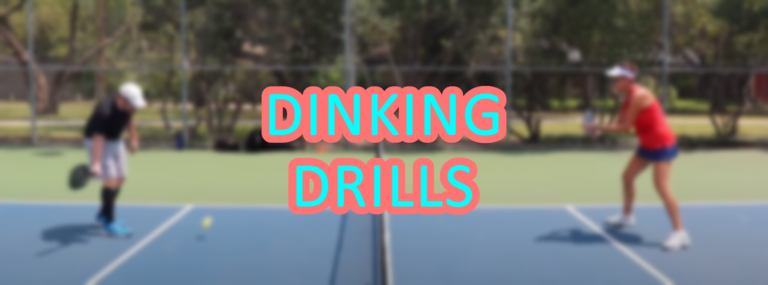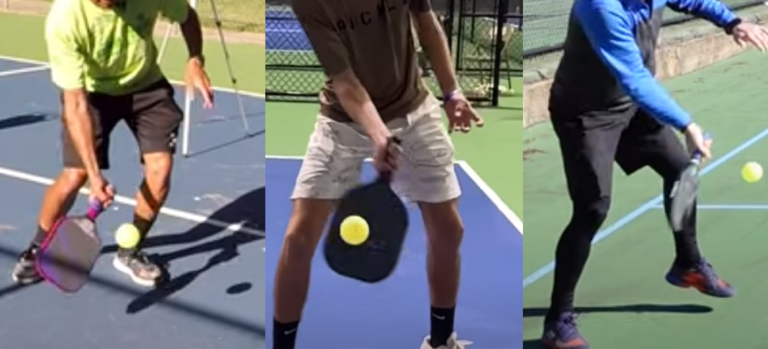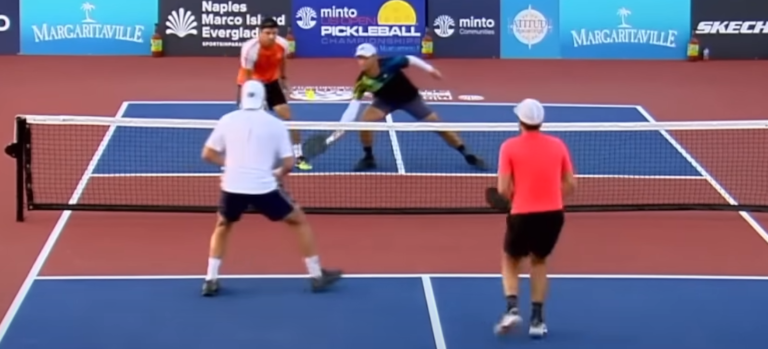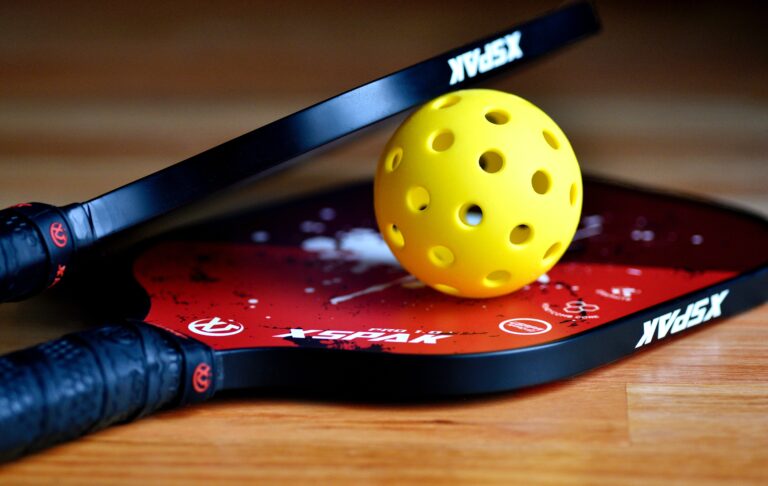Pickleball Footwork: Techniques and Drills for Improved Gameplay
Footwork is essential in pickleball because it allows players to move quickly and efficiently around the court in order to make shots. Without proper footwork, a player will be unable to keep up with their opponent’s pace and stay in position for potential returns. Good footwork can also help to improve one’s balance, allowing the player to remain steady when making a shot. To develop good footwork, players should work on their agility and stamina by doing drills such as ladder runs or jump-rope exercises. Additionally, pickleball players should practice various shots with different types of footwork in order to get a feel for how their feet need to move in order to complete each shot successfully. With effort and dedication, players can use the correct footwork to stay one step ahead of their opponents on the court.
Benefits of Proper Footwork in Pickleball
Footwork plays a crucial role in pickleball and is often regarded as one of the most essential aspects of the game. It involves the movement and positioning of the player’s feet on the court during play. The importance of footwork in pickleball can be summarized in several key points:
Court Coverage
Pickleball is a fast-paced sport with a small court, requiring players to cover the court efficiently. Proper footwork allows players to move quickly and reach the ball in time, ensuring they can respond to their opponent’s shots effectively and maintain good court coverage.
Shot Execution
Footwork is vital for setting up and executing various shots with precision and power. Whether it’s a dink, drop shot, volley, or groundstroke, proper footwork helps players get into an optimal position to hit the ball cleanly and accurately.
Balance and Stability
Good footwork ensures players maintain a balanced and stable stance during shots. It allows them to stay grounded and ready to react to their opponent’s shots while also enabling controlled and consistent strokes.
Recovery and Defense
Quick and efficient footwork is essential in recovering after hitting a shot and transitioning to a ready position for the next shot. It also aids in defensive play, allowing players to move laterally and cover the court effectively during rallies.
Minimizing Unforced Errors
Poor footwork can lead to unforced errors, where players miss shots they should have made. By improving footwork, players can reduce errors and enhance their overall performance on the court.
Strategic Movement
Footwork is not only about reacting to the ball but also strategically positioning oneself on the court. Players can use footwork to control the pace of the game, create angles, and exploit their opponents’ weaknesses.
Injury Prevention
Proper footwork techniques promote efficient movement, reducing the risk of injuries such as ankle twists or muscle strains. It also encourages players to move in a way that minimizes strain on their joints and muscles.
Overall, mastering footwork in pickleball enables players to become more versatile, agile, and efficient on the court. It contributes significantly to a player’s ability to maintain control, execute shots accurately, and stay competitive during intense pickleball matches.
Footwork Fundamentals and Techniques
The fundamentals of pickleball footwork are essential techniques and principles that form the foundation of efficient and effective movement on the pickleball court. By understanding and applying these fundamentals, players can improve their agility, court coverage, and shot execution.
Ready Position
The ready position is the fundamental starting stance in pickleball. Players should stand with their feet shoulder-width apart, knees slightly bent, and weight balanced on the balls of their feet. The paddle should be held in front of the body, and players should be ready to move in any direction.
Split-Step
The split-step is a crucial footwork technique that involves jumping slightly and landing with the feet apart just before the opponent hits the ball. This technique helps players react quickly to their opponent’s shots, allowing them to move more efficiently and reach the ball on time.
Proper Court Movement
Players should practice moving fluidly and efficiently around the court. This includes moving forward to attack short balls, moving backward to defend against deep shots, and moving sideways to cover the court laterally. Learning to move without unnecessary steps and in a balanced manner is essential for effective court coverage.
Balance and Weight Transfer
Maintaining good balance and knowing when and how to shift body weight during shots are crucial for controlled and accurate play. Proper weight transfer helps generate power and control while avoiding unforced errors.
Quick Recovery Steps
After hitting a shot, players should focus on quick recovery steps to return to a balanced ready position. This ensures they are prepared for their opponent’s response and can move efficiently to cover the court.
Directional Changes
Pickleball is a dynamic sport that requires players to change directions rapidly. Learning to use cross-over steps, side shuffles, and pivots effectively is essential for quick directional changes on the court.
Controlled Footwork for Different Shots
Different shots in pickleball require specific footwork techniques. For example, dinks and drop shots call for soft and controlled footwork, while groundstrokes and volleys may require more aggressive movement.
Staying on the Balls of the Feet
Being on the balls of the feet allows players to be more responsive and agile. It helps maintain good court balance, enabling quick movements in any direction.
By practicing and mastering these fundamentals of pickleball footwork, players can elevate their game, improve shot execution, cover the court more effectively, and become more confident and competitive on the pickleball court.
Mastering Footwork for Different Shots
Dinks and drops: Footwork for the net game
Pickleball footwork for dinks and drops around the net requires a combination of soft, controlled movements and quick adjustments to respond to the ball’s trajectory. Here’s a breakdown of the footwork techniques for both dinks and drops:
Dinks
- Ready Position: Start in the ready position, with your feet shoulder-width apart, knees slightly bent, and weight on the balls of your feet. Hold your paddle in front of your body at an angle to prepare for the dink shot.
- Minimal Steps: Dinking is a finesse shot, so aim to take small, controlled steps as you move towards the ball. Use short strides to maintain balance and readiness.
- Soft Pivot: As you approach the ball, use a soft pivot on your front foot to face the net. This allows you to direct the ball accurately and maintain better court coverage.
Drops
- Ready Position: Similar to dinks, start in the ready position with your feet shoulder-width apart and knees slightly bent. Hold your paddle comfortably in front of your body.
- Lateral Movement: For drops, you might need to move laterally along the net to get into the right position for the shot. Utilize side shuffling or quick cross-over steps to adjust your position as needed.
- Controlled Footwork: As the ball comes towards you, use controlled footwork to approach the ball while staying balanced. Keep your movements soft and precise to maintain control over the shot.
- Short Backswing: For drop shots, a shorter backswing is essential to control the ball’s trajectory and placement. Use your wrist to generate spin and finesse on the ball.
Important Tips:
- Stay light on your feet and ready to adjust quickly to the ball’s movement.
- Keep your movements relaxed and avoid lunging or reaching excessively for the ball.
- Focus on touch and precision rather than power for both dinks and drops.
- Maintain good body positioning and stay balanced to be ready for the next shot.
Remember, consistent practice and footwork drills specific to dinks and drops can significantly improve your proficiency in these shots. It’s essential to incorporate footwork training into your regular pickleball practice routine to enhance your overall performance on the court.
Groundstrokes: Positioning for forehands and backhands
Pickleball footwork for forehands and backhands involves a combination of lateral movement, proper positioning, and weight transfer to generate power and accuracy in your shots. Here’s a breakdown of the footwork techniques for both forehands and backhands:
Forehands
- Ready Position: Start in the ready position, with your feet shoulder-width apart, knees slightly bent, and weight on the balls of your feet. Hold your paddle in front of your body, ready to execute the forehand shot.
- Lateral Movement: Anticipate the direction of the incoming ball and move laterally towards it to set yourself up for the forehand shot. Utilize side shuffling or quick cross-over steps to adjust your position as needed.
- Footwork for Reach: If the ball is slightly out of your comfortable reach, perform a split-step just before your opponent hits the ball. This will help you react quickly and take a step towards the ball to reach it effectively.
- Weight Transfer: As you prepare to hit the forehand, transfer your weight from your back foot to your front foot. This weight transfer generates power in the shot and allows for better control.
Backhands
- Ready Position: Like with forehands, start in the ready position with your feet shoulder-width apart and knees slightly bent. Hold your paddle comfortably in front of your body, prepared for the backhand shot.
- Footwork for Reach: For balls that are slightly behind you, perform a split-step just before your opponent hits the ball. This will enable you to pivot on your back foot and move quickly towards the ball to set up for the backhand shot.
- Lateral Movement: Anticipate the direction of the incoming ball and move laterally to position yourself correctly for the backhand shot. Utilize side shuffling or quick cross-over steps to adjust your position as needed.
- Weight Transfer: As you execute the backhand, transfer your weight from your front foot to your back foot. This weight transfer generates power in the shot and aids in maintaining balance during the swing.
Important Tips
- Keep your body balanced and maintain a stable stance during your shots.
- Utilize split-steps just before your opponent hits the ball to stay ready to move and respond quickly.
- Focus on proper footwork and body positioning to ensure consistent and controlled shots.
- Practice footwork drills that specifically target forehands and backhands to enhance your skills.
Consistent practice and attention to footwork will significantly improve your ability to execute forehands and backhands effectively, leading to better performance on the pickleball court. Incorporate footwork training into your regular practice sessions to refine your footwork technique and enhance your overall gameplay.
Volleys: Movement techniques for effective net play
Pickleball footwork for volleys is crucial for maintaining control and reacting quickly to the fast-paced nature of the game at the net. Volleys are shots that are taken in mid-air without letting the ball bounce, usually close to the net. Here’s a breakdown of the footwork techniques for volleys:
- Ready Position: Start in the ready position near the non-volley zone (kitchen) line, with your feet shoulder-width apart and knees slightly bent. Hold your paddle out in front of your body, ready to intercept any balls hit within your reach.
- Minimal Steps: Volleys require quick reactions, so aim to take minimal steps when positioning yourself for the shot. Instead of large strides, use small adjustments in your footwork to get into the right position.
- Soft Pivot: As the ball approaches you, use a soft pivot on your front foot to face the net. This allows you to maintain a square stance and direct the ball with precision.
- Stay Light on Your Feet: Be prepared to move quickly in any direction to respond to the ball. Being light on your feet allows for swift lateral movement, making it easier to cover the court and react to opponents’ shots.
- Eye on the Ball: Keep your eyes focused on the ball at all times. This will help you read the ball’s trajectory and respond more effectively.
- Ready Hands: Keep your paddle up and ready to intercept the ball. This ensures that you are in a prime position to react to fast shots and execute volleys with control.
- Split-Step: Use a split-step just before your opponent hits the ball. The split-step involves a small jump and landing with your feet shoulder-width apart. This prepares you to move quickly in any direction, enabling better court coverage and reaction time.
- Controlled Swing: When hitting volleys, focus on using a controlled and compact swing. Avoid big backswings, as they may result in less control and slower reaction times.
Important Tips:
- Mastering the volley requires quick reflexes and anticipation. Practice volley drills to improve your reaction time and hand-eye coordination.
- Avoid swinging at the ball too early or too late. Time your volley shots well to ensure clean contact with the ball.
- Volley shots are often softer and placed shots rather than powerful strikes. Aim for precision and placement over power.
Consistent practice and refining your footwork technique for volleys will enhance your ability to control the net and respond swiftly to opponents’ shots. Incorporate volley-specific footwork drills into your regular pickleball practice to develop the necessary skills for successful volley play.
Footwork during serves and returns
Pickleball footwork for serves and returns is essential for setting up a strong offensive position or quickly adjusting to return opponents’ shots. Both serve and return footwork require a combination of proper positioning, balance, and quick movements. Here’s a breakdown of the footwork techniques for serves and returns:
Serves
- Stance and Positioning: Start with your feet shoulder-width apart, and position yourself behind the baseline, ready to serve. Stand with one foot slightly ahead of the other, with your weight on the back foot for better balance and to facilitate forward movement during the serve.
- Ball Toss and Timing: Toss the ball with your non-dominant hand at the appropriate height and distance, slightly in front of your hitting shoulder. As you toss the ball, prepare your paddle to make contact at the desired spot.
- Forward Step and Transfer Weight: As you swing your paddle to hit the ball, take a small forward step with your front foot to generate power and transfer your weight into the shot. The weight transfer from back foot to front foot adds force to your serve.
- Follow-Through: Complete your serve with a smooth follow-through, extending your arm forward and upward. Land on your front foot to maintain balance and prepare for the next shot.
Returns
- Ready Position: Stand in the ready position with your feet shoulder-width apart and knees slightly bent, ready to react to your opponent’s serve. Hold your paddle comfortably in front of your body, prepared to return the serve.
- Split-Step: Perform a split-step just before your opponent makes contact with the ball. The split-step involves a small jump and landing with your feet shoulder-width apart. This prepares you to move quickly in any direction to return the serve effectively.
- Positioning: Read the trajectory of your opponent’s serve and quickly adjust your positioning to meet the ball. Depending on the serve’s speed and direction, you may need to move forward, backward, or sideways to get into an ideal return position.
- Controlled Return: Use controlled footwork to position yourself for the return and time your shot well. Aim for placement rather than power on your return to maintain control and set up the point.
- Quick Adjustment: Stay light on your feet and be ready to adjust to different types of serves, including deep serves, short serves, and serves with spin. Quick and precise footwork enables better court coverage and return accuracy.
Important Tips
- Keep your movements efficient and avoid unnecessary steps during serves and returns to maintain balance and reaction time.
- For returns, focus on reading your opponent’s serve early to anticipate the shot and get into position.
- Practice various serve and return drills to improve your footwork and shot execution.
By mastering the footwork techniques for serves and returns, you can gain an advantage in controlling the game from the start and responding effectively to your opponent’s shots. Regular practice and refinement of your footwork will enhance your overall pickleball performance.
Footwork Drills to Elevate Your Game
Pickleball footwork drills are specific exercises designed to improve players’ movement, agility, and court coverage. These drills focus on various aspects of footwork, such as lateral movement, quick reactions, and positioning. Performing footwork drills regularly can enhance your overall pickleball performance and make you a more efficient and effective player on the court. Here are some pickleball footwork drills and how to do them:
Lateral Side Shuffle
- Start in the ready position with your feet shoulder-width apart.
- Perform a lateral side shuffle to one side, moving quickly and maintaining a low and balanced stance.
- Repeat the side shuffle to the opposite side.
- Continue side shuffling back and forth for a set duration or number of repetitions.
X-Drill
- Set up four cones in the shape of an “X” on the court, with each cone a few feet apart.
- Start at the center of the X and perform the following sequence: run to the first cone, touch it with your hand, then backpedal to the center, run to the second cone, touch it, and backpedal to the center, and so on.
- Repeat the sequence several times, focusing on quick transitions and staying light on your feet.
Drop Step Drill
- Have a partner stand at the baseline and feed balls to different areas of the court.
- Start at the center of the baseline and, as your partner hits the ball, perform a quick drop step and move towards the ball to hit the return.
- Reset to the starting position after each shot and repeat for multiple returns.
Around-the-Cone Drill
- Set up a cone on each side of the non-volley zone line.
- Start at one cone and quickly side shuffle to the other cone, touching it with your hand.
- Side shuffle back to the starting cone, touch it, and repeat the sequence.
- Continue side shuffling around the cones for a set duration or number of repetitions.
Reaction Drill
- Stand in the ready position, and have a partner stand a few feet away with a ball in hand.
- Your partner will randomly drop the ball, and you must react quickly to catch it before it bounces twice.
- Vary the direction and speed of the drops to challenge your reaction time and footwork.
Target Hitting
- Place targets in different areas of the court, such as the corners or sidelines.
- Have a partner feed balls to you, and your goal is to hit the ball to the designated targets.
- Focus on footwork and positioning to aim accurately for the targets.
Important Tips
- Perform these drills at a pace that challenges you but allows you to maintain proper form.
- Focus on quick footwork and proper technique during each drill.
- Mix and match different footwork drills to add variety to your practice routine.
Consistent practice of these pickleball footwork drills will help improve your movement, agility, and court coverage, ultimately enhancing your overall performance on the pickleball court.
Common Pickleball Footwork Mistakes to Avoid
Avoiding common pickleball footwork mistakes is essential to becoming a more efficient and effective player on the court. Proper footwork can enhance your court coverage, shot execution, and overall gameplay. Here are some common footwork mistakes to avoid:
Standing Flat-Footed
Remaining flat-footed during gameplay can hinder your ability to move quickly and react to shots. Always stay on the balls of your feet, allowing for more agility and responsiveness to the ball.
Improper Ready Position
Failing to start in the ready position can lead to delayed reactions and missed opportunities. Always maintain the ready position with knees slightly bent, paddle up, and prepared to move in any direction.
Overstriding
Taking overly large strides can throw off your balance and limit your ability to change direction quickly. Focus on taking controlled and smaller steps to maintain better stability.
Lunging
Lunging for the ball can lead to instability and decreased control over your shots. Instead, use proper footwork to position yourself correctly for the shot without excessive reaching.
Neglecting Split-Step
Neglecting to use the split-step before your opponent hits the ball can delay your reaction time. Incorporate the split-step into your footwork to be ready to move in any direction instantly.
Forgetting Weight Transfer
Failing to transfer your weight effectively during shots can result in weak or inaccurate hits. Use weight transfer to generate power and control in your shots.
Slow Recovery Steps
After hitting a shot, taking slow or inefficient recovery steps can hinder your ability to get back into position quickly. Prioritize quick recovery steps to stay prepared for your opponent’s response.
Lack of Court Awareness
Not paying attention to your positioning on the court can lead to poor shot choices and vulnerability to opponents’ attacks. Be aware of your position and adjust accordingly during gameplay.
Overlooking Footwork Practice
Neglecting to practice specific footwork drills can impede your progress as a player. Regularly incorporate footwork exercises into your practice routine to improve your movement and court coverage.
By avoiding these common footwork mistakes and focusing on proper technique, you can significantly improve your performance on the pickleball court. With practice and mindfulness, you can enhance your footwork skills and become a more versatile and successful pickleball player.
Footwear and Gear Considerations
Choosing the right pickleball shoes is essential for optimal support and traction, significantly impacting pickleball footwork. Proper footwear provides the necessary stability and grip to execute quick lateral movements and respond swiftly to opponents’ shots. Shoes with excellent cushioning reduce the strain on joints, minimizing the risk of injuries during intense gameplay. \
On the other hand, comfortable clothing and well-fitted equipment are equally important for unhindered movement on the court. Comfortable apparel made of moisture-wicking materials keeps players dry and cool, enabling them to focus on their footwork without distractions. Well-fitted paddles and grips provide better control, enhancing shot execution.
Together, the right shoes, comfortable clothing, and well-maintained equipment improve footwork, allowing players to move more efficiently, maintain better balance, and cover the court effectively, ultimately elevating their overall performance in pickleball.
Conclusion
Pickleball footwork is an important aspect of the game that should not be overlooked. Utilizing proper and efficient footwork can help you stay in control on the court while also allowing for quicker recovery to shots. By focusing on improving your stance, balance, agility and speed with tailored drills and exercises, as well as understanding how they all work together during a match situation – you’ll soon find yourself having much greater success when playing pickleball! With practice being key to mastering any skill or technique – it’s time to get out there and put these principles into action so you can take your game to the next level!
